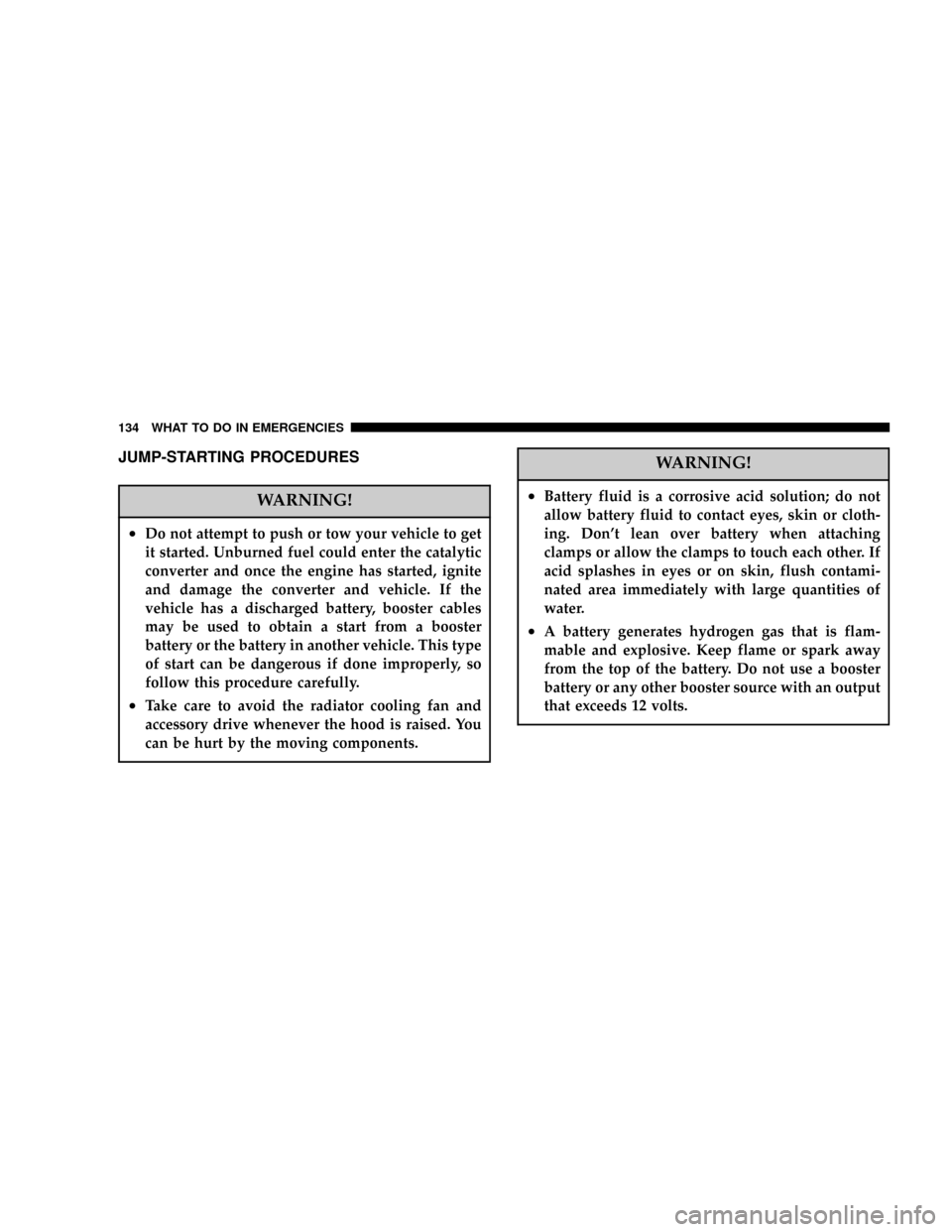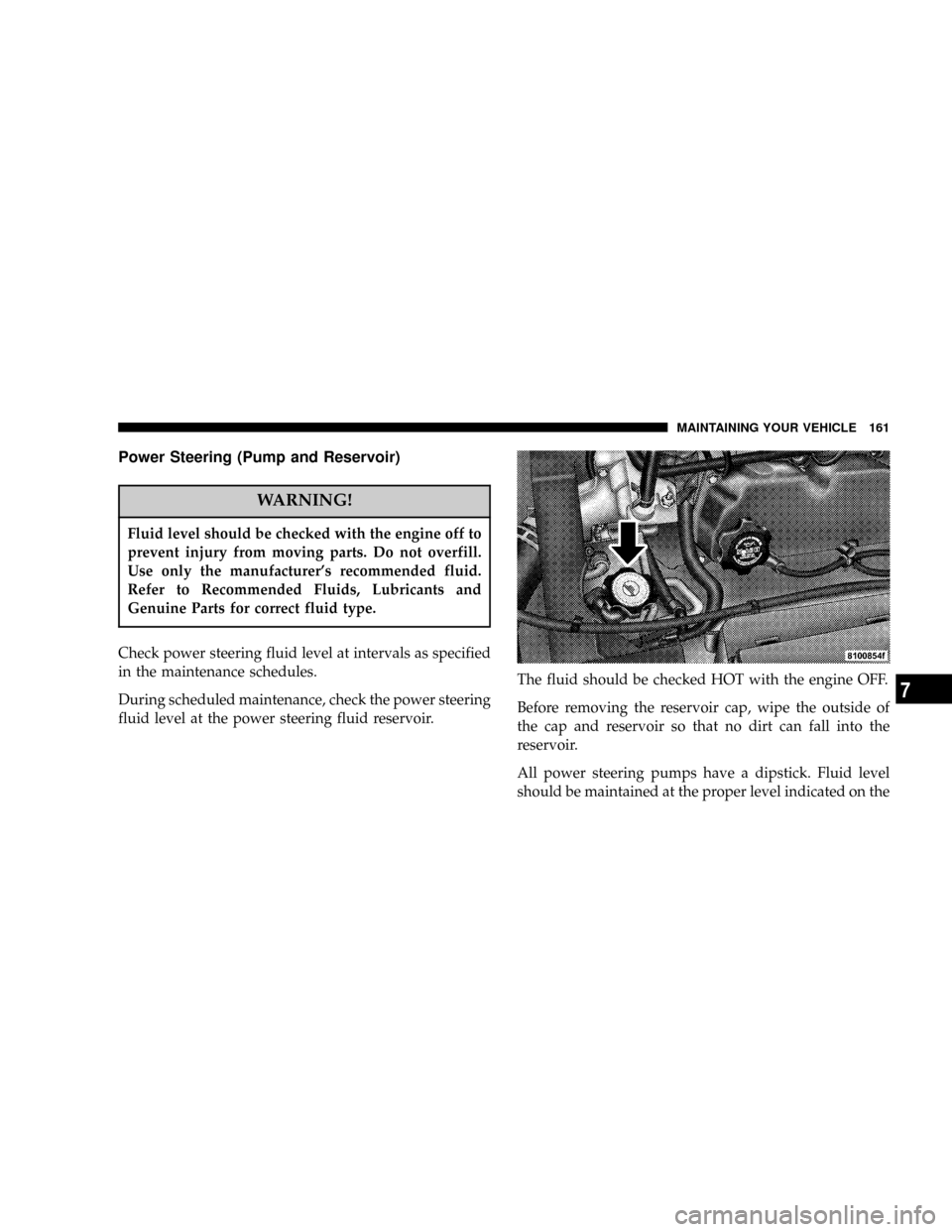warning DODGE VIPER 2004 ZB / 2.G Workshop Manual
[x] Cancel search | Manufacturer: DODGE, Model Year: 2004, Model line: VIPER, Model: DODGE VIPER 2004 ZB / 2.GPages: 236, PDF Size: 4.18 MB
Page 132 of 236

HAZARD WARNING FLASHER
The flasher switch is on the top of the steering
column, just behind the steering wheel. Depress
the flasher button and all front and rear directional
signals will flash. Depress the flasher button again to turn
the flashers off.Do not use this emergency warning system when the
vehicle is in motion. Use it when your vehicle is disabled
and is creating a safety hazard for other motorists.
If it is necessary to leave the vehicle to go for service, the
flasher system will continue to operate with the ignition
key removed.
NOTE:With extended use, the flasher may run down
your battery.
IF YOUR ENGINE OVERHEATS
In any of the following situations, you can reduce the
potential for overheating by taking the appropriate ac-
tion.
²On the highways ÐSlow down and use the highest
gear possible.
²In city traffic ÐWhile stopped, put the transmission
in neutral, but do not increase engine idle speed.
132 WHAT TO DO IN EMERGENCIES
Page 133 of 236

²In city trafficÐWhile moving, shift into the highest
gear possible to reduce engine RPM.
NOTE:There are steps that you can take to slow down
an impending overheat condition. If your air conditioner
is on, turn it off. The air conditioning system adds heat to
the cooling system and turning off the A/C removes this
heat. You can also turn the Temperature control to
maximum heat, the Mode control to floor, and the fan
control to High. This allows the heater core to act as a
supplement to the radiator and aids in removing heat
from the cooling system.WARNING!
A hot cooling system is dangerous. You or others
could be badly burned by steam or boiling coolant.
If your temperature gauge pointer is in the red area,
turn off the engine immediately. You may want to
call a service center for service. If you decide to look
under the hood yourself, see Section 7 of this
manual. Follow the warnings under the Radiator
Cap paragraph.
WHAT TO DO IN EMERGENCIES 133
6
Page 134 of 236

JUMP-STARTING PROCEDURES
WARNING!
²Do not attempt to push or tow your vehicle to get
it started. Unburned fuel could enter the catalytic
converter and once the engine has started, ignite
and damage the converter and vehicle. If the
vehicle has a discharged battery, booster cables
may be used to obtain a start from a booster
battery or the battery in another vehicle. This type
of start can be dangerous if done improperly, so
follow this procedure carefully.
²Take care to avoid the radiator cooling fan and
accessory drive whenever the hood is raised. You
can be hurt by the moving components.
WARNING!
²Battery fluid is a corrosive acid solution; do not
allow battery fluid to contact eyes, skin or cloth-
ing. Don't lean over battery when attaching
clamps or allow the clamps to touch each other. If
acid splashes in eyes or on skin, flush contami-
nated area immediately with large quantities of
water.
²A battery generates hydrogen gas that is flam-
mable and explosive. Keep flame or spark away
from the top of the battery. Do not use a booster
battery or any other booster source with an output
that exceeds 12 volts.
134 WHAT TO DO IN EMERGENCIES
Page 137 of 236

and the other end to the engine of the other vehicle. Make
sure that you have a good contact on the engines.
NOTE:When using another vehicle as the power
source, turn off all accessories.
8. Turn off the Theft Security System.
NOTE:If system is not turned off, the Theft System
electronics will prevent the engine from starting.
9. Allow battery to charge to at least 12.4 volts before
attempting to start engine.
10. Start the engine in the booster vehicle and let the
engine idle for a few minutes. Then start the Viper
engine. If engine does not start in 15 seconds, stop
cranking engine and allow starter to cool down before
cranking again.
11. When removing the booster cables, reverse the above
sequence exactly.DRIVING ON SLIPPERY SURFACES
WARNING!
Rapid acceleration on slippery surfaces is danger-
ous. You could lose control of the vehicle and possi-
bly have an accident. Accelerate slowly and carefully
whenever there is likely to be poor traction (ice,
snow, wet, mud, loose sand, etc.).
Traction
When driving on wet or slushy roads, it is possible for a
wedge of water to build up between the tire and road
surface. This is hydroplaning and may cause partial or
complete loss of vehicle control and stopping ability. To
reduce this possibility, the following precautions should
be observed:
WHAT TO DO IN EMERGENCIES 137
6
Page 148 of 236

NOTE:Intentional tampering with emissions control
systems can result in civil penalties being assessed
against you.
WARNING!
You can be badly injured working on or around a
motor vehicle. Do only that service work for which
you have the knowledge and the proper equipment.
If you have any doubt about your ability to perform
a service job, take your vehicle to a competent
mechanic.
MAINTENANCE PROCEDURES
The pages that follow contain the maintenance service
recommendations by the engineers who designed your
vehicle.
Besides the maintenance items for which there are fixed
maintenance intervals, there are other items that should
operate satisfactorily without periodic maintenance.
However, if a malfunction of these items does occur, it
could adversely affect the engine or vehicle performance.
These items should be inspected if a malfunction is
observed or suspected.
Engine Oil
Checking Oil Level
To assure proper lubrication of your vehicle's engine, the
engine oil must be maintained, at the correct level. Check
the oil level at regular intervals, such as every fuel stop.
148 MAINTAINING YOUR VEHICLE
Page 154 of 236

WARNING!
A hot exhaust system can start a fire if you park over
materials that can burn. Such materials might be
grass or leaves coming into contact with your ex-
haust system. Do not park or operate your vehicle in
areas where your exhaust system can contact any-
thing that can burn.
In unusual situations involving grossly malfunctioning
engine operation, a scorching odor may suggest severe
and abnormal catalyst overheating. If this occurs, stop
the vehicle, turn off the engine and allow it to cool.
Service, including a tune up to manufacturers specifica-
tions, should be obtained immediately.To minimize the possibility of catalytic converter dam-
age:
²Do not shut off the engine or interrupt the ignition
when the transmission is in gear and the vehicle is in
motion.
²Do not try to start the engine by pushing or towing the
vehicle.
²Do not idle the engine with any spark plug wires
disconnected for prolonged period.
Ignition Wiring System and Ignition Timing
The ignition cables should be kept clean and properly
connected. Terminals should be fully seated. Do not
remove the nipple assemblies from the coil towers unless
the nipples are damaged or cable testing shows high
resistance or broken insulation. Refer to the Service
154 MAINTAINING YOUR VEHICLE
Page 155 of 236

Manual for the proper procedure to be followed for
checking ignition cable resistance. Cracked, damaged, or
faulty cables should be replaced.
Because of the plastic body shell on your Viper, ignition
cables should be replaced with the specially designed RFI
cables available at your dealer.
Ignition timing cannot be set on this vehicle.
Crankcase Emission Control System
Proper operation of this system depends on freedom
from plugging due to deposits. As vehicle mileage builds
up, the Crankcase Ventilation Valve orifice may accumu-
late deposits. If a valve is not working properly, replace it
with a new orifice. DO NOT ATTEMPT TO CLEAN THE
OLD ORIFICE!
Check the ventilation hose for indication of damage or
plugging deposits. Replace if necessary.
Air Cleaner Filter
Under normal driving conditions, replace the air filter at
the intervals shown on ªMaintenance Schedule Aº. If,
however, you drive the vehicle frequently under dusty or
severe conditions, the filter element should be inspected
periodically and replaced if necessary at the intervals
shown in ªMaintenance Schedule Bº.
WARNING!
The air cleaner can provide protection if the engine
backfires. Do not remove the air cleaner unless such
removal is necessary for repair or maintenance.
Make sure that no one is near the engine compart-
ment before starting the vehicle with the air cleaner
removed. Failure to do so can result in serious
personal injury.
MAINTAINING YOUR VEHICLE 155
7
Page 157 of 236

10. Tighten the positive battery post and then tighten the
negative battery post.
11. Install the battery cover and tighten down the screws.
WARNING!
Battery fluid is a corrosive acid solution and can
burn or even blind you. Don't allow battery fluid to
contact your eyes, skin or clothing. Don't lean over a
battery when attaching clamps. If acid splashes in
eyes or on skin, flush the area immediately with
large amounts of water. Battery gas is flammable and
explosive. Keep flame or sparks away from the
battery. Don't use a booster battery or any other
booster source with an output greater than 12 volts.
Don't allow cable clamps to touch each other.
WARNING!
Battery posts, terminals and related accessories con-
tain lead and lead compounds. Wash hands after
handling.
MAINTAINING YOUR VEHICLE 157
7
Page 160 of 236

1. Press the driver's door exterior handle to wake up the
vehicle.
2. If the door does not open (vehicle is armed) press the
remote keyless entry unlock button to unlock the vehicle.
3. Press the driver's door exterior handle again to open
the door.
4. Cycle the Ignition to ON/RUN. If the ignition is NOT
cycled to ON/RUN, then the vehicle will re-enter Battery
Save Mode 45 seconds after the driver's door is closed.
Air Conditioner
Check the air conditioning system operation at the start
of the warm weather season.
NOTE:If air conditioning operation seems to be lower
than expected, check the front of the A/C condenser,
located in front of the radiator for dirt or insect accumu-
lation. Clean with a gentle water spray as required. Frontend fascia protectors may reduce air flow to the con-
denser and radiator, reducing A/C and engine cooling
performance.
WARNING!
The air conditioning system contains refrigerant
under high pressure. To avoid risk of personal injury
or damage to the system, adding refrigerant or any
repair requiring lines to be disconnected should be
done by an experienced repairman.
Refrigerant Recovery and Recycling
The air conditioning system of your vehicle contains
R-134a, a refrigerant that does not deplete the ozone layer
in the upper atmosphere. The manufacturer recommends
that air conditioning service be done by facilities using
refrigerant recycling and recovery equipment that meets
SAE standard J1991.
160 MAINTAINING YOUR VEHICLE
Page 161 of 236

Power Steering (Pump and Reservoir)
WARNING!
Fluid level should be checked with the engine off to
prevent injury from moving parts. Do not overfill.
Use only the manufacturer's recommended fluid.
Refer to Recommended Fluids, Lubricants and
Genuine Parts for correct fluid type.
Check power steering fluid level at intervals as specified
in the maintenance schedules.
During scheduled maintenance, check the power steering
fluid level at the power steering fluid reservoir.The fluid should be checked HOT with the engine OFF.
Before removing the reservoir cap, wipe the outside of
the cap and reservoir so that no dirt can fall into the
reservoir.
All power steering pumps have a dipstick. Fluid level
should be maintained at the proper level indicated on the
MAINTAINING YOUR VEHICLE 161
7